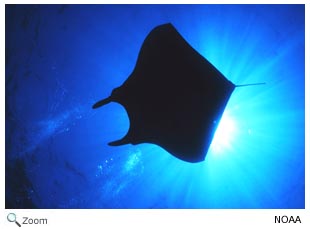 There are 10 species in this family. They are found in tropical and subtropical ocean waters in the
Atlantic, Pacific, and Indian oceans. They have large pectoral fins and whip-like tails with a small dorsal fin. They also have two horn-like fins on their heads. These are called
cephalic fins. There are 10 species in this family. They are found in tropical and subtropical ocean waters in the
Atlantic, Pacific, and Indian oceans. They have large pectoral fins and whip-like tails with a small dorsal fin. They also have two horn-like fins on their heads. These are called
cephalic fins.
The cephalic fins are actually an extension of their pectoral fins. The cephalic fins look like devil horns, and the rays in this family are sometimes called devil rays.
Manta rays have five gill slits on their undersides. They feed by straining fish and plankton out of the water. Like the eagle rays, they propel themselves through the water by flapping their pectoral fins. The giant manta ray is a member of this family. It can be up to 22 feet across!
World Status Key
 Least Concern Least Concern  Near Threatened Near Threatened  Vulnerable Vulnerable  Endangered Endangered  Critically Endangered Critically Endangered  Extinct in Wild Extinct in Wild  Extinct Extinct
Status and range is taken from ICUN Redlist. If no status is listed, there is not enough data to establish status.
US Status Key
 Threatened in US Threatened in US  Threatened in NH Threatened in NH  Endangered in US Endangered in US  Endangered in NH Endangered in NH  Introduced Introduced
Status taken from US Fish and Wildlife and NH Fish and Game
|

